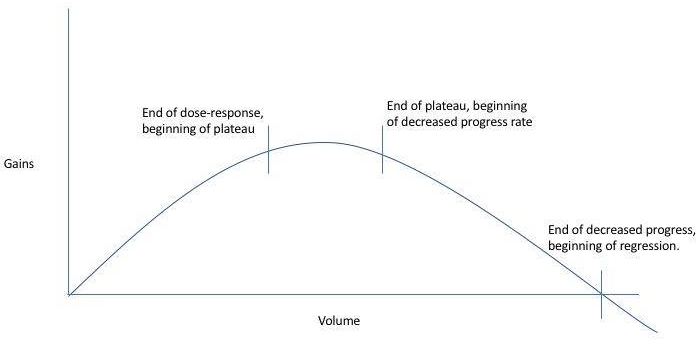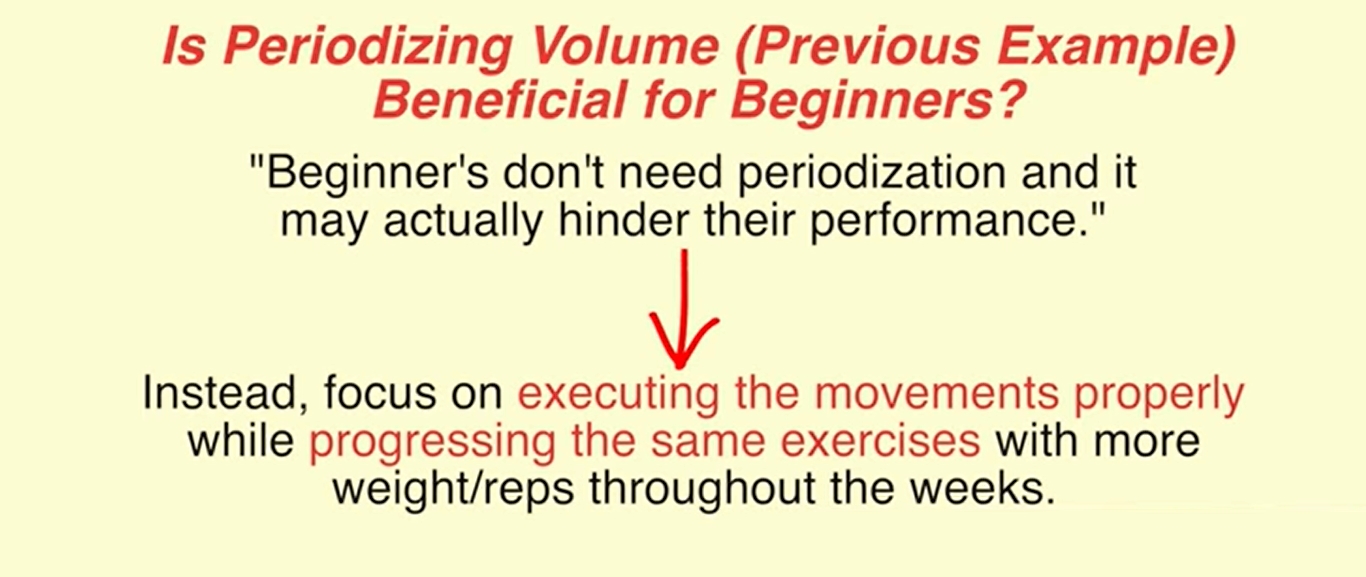Muscles only grow if they are given sufficient growth stimuli. That is why you do multiple exercises and sets for each muscle group. But how many sets is actually optimal?
1. Muscles grow mainly by the effective repetitions in a set (the repetitions near muscle failure). Doing multiple sets per muscle group means more effective reps and therefore more muscle growth.
2. However, muscle growth potential and recovery capacity are limited, so that after a certain amount of sets there is no return. After an even larger amount of sets, there is even a threat of muscle breakdown.
3. Sets are productive if you train them close to muscle failure. However, avoid training to complete muscle failure as it causes disproportionate fatigue. As a result, you can do significantly fewer sets, which on balance means less muscle growth. Therefore, for most sets, keep a few reps in the tank (1-3 Reps In Reserve).
4. Due to adaptation, the volume requirement increases. That means you’ll have to do more sets along the way to keep growing.
5. Beginners need about 10 sets per week per muscle group, intermediates 10-15, advanced 15-20 and even more advanced more than 20.
6. You can do a maximum of 10 sets of productive volume per muscle group per workout. If you need to do more than 10 sets per week to grow, spread them over several workouts, which means an increase in training frequency.
THE IMPORTANCE OF SETS
Muscles are especially stimulated by the exhausting repetitions in a set, also called stimulating or effective repetitions. In order to grow, they need enough of those repetitions. That is why you have to do several sets for each muscle group every week, and each set must be trained with sufficient effort (so to or close to muscle failure).
The number of sets per muscle group per week is also known as the training volume. Training volume is the most important training variable next to training intensity (load and effort). Effort (how short you train for muscle failure) is also called the relative intensity. Together with the number of sets, this determines how many stimulating repetitions you do and therefore also how much muscle growth you achieve.
 You create a growth stimulus by doing enough sets and by making sufficient effort per set, so by training until (near) muscle failure.
You create a growth stimulus by doing enough sets and by making sufficient effort per set, so by training until (near) muscle failure.CRITERIA OF A SET
To count sets as training volume, they must be challenging and thus lead to serious fatigue. In other words, they must deliver enough effective reps. Warm-up sets are not counted for that reason.
It therefore concerns the so-called ‘tough sets’, which, according to a meta-study, meet two criteria:
- they have sufficient repetitions, but also not exaggerated (so between 6 and 20 reps);
- they are trained with sufficient effort, namely a minimum of 3 RIR (ie you train to or near muscle failure, and keep a maximum of 3 reps in the tank)*.
* Although you have to make sufficient effort per set, it is better not to train to complete muscle failure. That hardly results in extra muscle growth, while it does cause a lot of extra fatigue. As a result, you can do less volume and therefore on balance less effective repetitions. Therefore, keep 1-3 Reps In Reserve (RIR) for most sets.
COUNTING SETS
When calculating training volume, we always include indirect work. That means we count fractional sets for muscles that help in large compound exercises. 3 sets yields bench press then yields, for example, 3 sets chest, 2 sets (front) shoulders and 1.5 sets triceps. In our opinion, this way you get the most accurate calculation.
However, in training volume recommendations, most coaches only use direct sets. As a result, the recommended volumes for arms, shoulders, trapezius, abdomen and buttocks are lower. After all, these are muscle groups that are also trained indirectly.
RESEARCH
The optimal number of sets for muscle growth differs greatly from person to person and is mainly dependent on genetic factors on the one hand and training status (beginner, intermediate and advanced bodybuilder) on the other. Fortunately, this subject is often scientifically researched, which allows us to arrive at increasingly concrete guidelines.
MORE IS BETTER – UP TO A POINT
In general, research shows that more volume produces more muscle growth, but up to a certain height. From a certain number of sets that growth stagnates and from the next point you even risk muscle breakdown, because your body can no longer recover sufficiently from the workload. The relationship between sets and muscle growth is therefore also referred to as an inverse U-shaped relationship .
 How the accumulation of training volume reaches a plateau and eventually even leads to muscle breakdown. (source: Facebook Eric Helms)
How the accumulation of training volume reaches a plateau and eventually even leads to muscle breakdown. (source: Facebook Eric Helms)From two meta-studies (Schoenfeld 2016 and Krieger 2010) plus a number of recent studies (1 , 2 , 3) we can conclude that you can already achieve muscle growth with 5 sets per muscle group per week, but that muscle growth is greater with 10 sets. For average bodybuilders, the optimal number is probably somewhere between 10 and 20.
VOLUME REQUIREMENT AND TRAINING STATUS
Intermediate and advanced bodybuilders generally need more volume than beginners. This is because the body has adapted to a certain volume over time (adaptation).
Roughly speaking, the volume requirement evolves during a training career as follows:
- beginners: ~10 sets per muscle group per week
- intermediates*: 10-15 sets per muscle group per week
- advanced: 15-20 sets per muscle group per week
- more advanced: 20+ sets per muscle group per week**
** If advanced bodybuilders need more volume for a muscle group than their total recovery capacity allows, they can do specialization blocks, where the other muscle groups are trained on maintenance volume.
MAXIMUM RECOVERABLE VOLUME
The absolute ceiling seems to be around 20-25 sets. If you do even more sets, your body may not be able to recover optimally. Coach and scientist Mike Israetel calls this Maximum Recoverable Volume (MRV) .
Isreatel’s guidelines for volume, called “Training Volume Landmarks”, are discussed in detail in our article on training volume.
NUMBER OF SETS PER WORKOUT
Finally, there is also a productive and recoverable volume per workout. You can only stimulate a limited amount of muscle growth per training. Research suggests that the growth stimulus already decreases sharply after 5 sets, to stagnate around 10 sets (seen per muscle group). If you do more than 10 sets for a muscle group, it will no longer result in muscle growth and only cause unnecessary muscle damage.
The total MRV per training is somewhere between 20 and 30 sets, depending on the type of exercises and the intensity you use.
TRAINING FREQUENCY
The fact that you can only do a limited number of productive and recoverable sets per workout means that you may need to spread your weekly volume over several sessions. Only if you need less than 10 sets per muscle group per week to grow (as is usually the case with beginners), you can still train each muscle group once a week.
So once you hit the threshold of 10 sets per muscle group per workout, increase your training frequency, says Brad Schoenfeld. Intermediates, who have to do about 15 sets per muscle group per week on average, should therefore train their muscle groups at least twice a week, taking into account sufficient recovery time after each training***. As you get more advanced, it’s a good idea to increase your exercise frequency even further.
Training frequency is therefore primarily a tool for structuring and optimizing larger volumes of volume.
PRACTICAL GUIDELINES
And so we’ve come to the following practical guidelines for training volume. Just ‘guidelines’, because you will have to find out for yourself, while experimenting, what the optimal training volume is for you.
- Sets are optimal if you use between 6 and 20 reps and put in enough effort. Therefore train close to muscle failure. To prevent disproportionate fatigue, however, do not train to complete muscle failure: you keep 1-3 Reps In Reserve.
- The optimal number of sets per muscle group per week is somewhere between 10 and 20 for most natural bodybuilders.
- For beginners, approximately 10 sets are probably sufficient. As a beginner, it is usually not necessary to do more sets: it will not give you extra muscle growth and will unnecessarily demand a lot from your recovery capacity. Get the most out of the least, is the credo.
- Intermediates usually need more volume to achieve muscle growth: between 10 and 15 sets per muscle group per week.
- Advanced bodybuilders, as a result of further adaptations, need even more volume to be able to grow: 15-20 sets per muscle group per week. Even more advanced may need even more than 20 sets and therefore got to do specialization blocks.
- Only increase the number of sets if you make little or no progress according to the guidelines of muscle growth potential, provided you are sure that you are recovering sufficiently and that your diet and rest are in order.
- From a certain number of sets, the body can no longer recover sufficiently, the Maximum Recoverable Volume (MRV). That varies from 15 to 25 sets per muscle group per week, depending on your training status and the training intensity you use.
- Do a maximum of 5-10 sets per muscle group and a maximum of 20-30 sets in total per workout.
- Increase your training frequency if the volume per session threatens to become too much. If you need more than 10 sets per week for a muscle group to grow, it is best to spread it over at least 2 weekly sessions.
CYCLE TRAINING VOLUME
You don’t have to constantly train at the same volumes during a training block (or mesocycle). Mike Israetel, in particular, is a strong advocate of progression in sets over a mesocycle (usually a 5-8 week period followed by a deload).
By starting such a cycle with a slightly lower volume and slowly building it up to your MRV, you may be able to dose your fatigue better, thereby recovering better and thereby realizing more muscle growth. Whether and to what extent this is actually the case, however, has not yet been sufficiently researched.
 Source: Jeremy Ethier/YouTube
Source: Jeremy Ethier/YouTubeAccording to Schoenfeld, volume cycling only makes sense if you’re a more advanced bodybuilder. He believes that beginners should focus on linear progression, i.e. keep as many training variables the same as possible and only achieve gradual increases in number of repetitions and/or weight:
 Source: Jeremy Ethier/YouTube
Source: Jeremy Ethier/YouTubeTHE MISTAKE WITH VOLUME
One of the most common mistakes made among natural bodybuilders is using too much training volume. Many bodybuilders do way too many sets, both per workout and on a weekly basis.
Prolonged copious volume leads to overreaching, the pre-stage of overtraining, resulting in muscle breakdown.